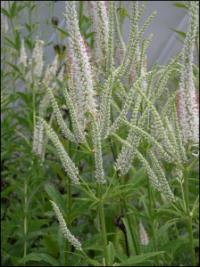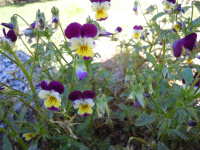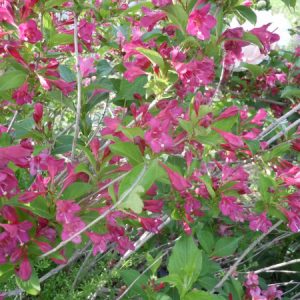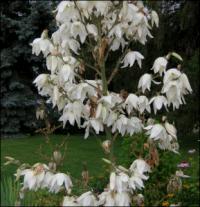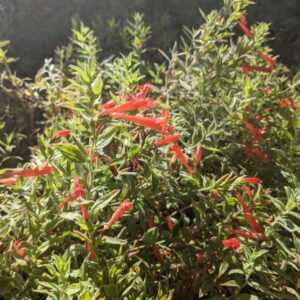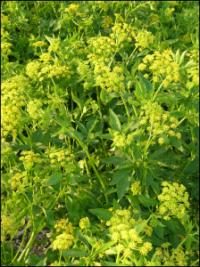Our Plants
Showing 609–616 of 616 results
-
Veronicastrum virginianum, Culver’s root Z 4-9
Tall, graceful ivory spires made of multitudes of small tubes crowd along the stem, arranged like a candelabra, bloom from early to mid-summer.
Tall, graceful ivory spires made of multitudes of small tubes crowd along the stem, arranged like a candelabra, bloom from early to mid-summer.
Size: 4' x 18"
Care: full sun to part shade in moist soil
Native: From Canada to Texas incl. Wisconsin native
Wildlife Value: Numerous bee species, including the Rusty patched Bumble Bee wasps and butterflies collect pollen and drink the nectar.Used by American Indians as a laxative and to induce vomiting and clean blood. Cherokee cured typhus and inactive livers with Culver’s root. Seneca Indians used the root in their ceremonies. Sioux also used this to stimulate the liver. They also burned the root for the smoke to purify those who had contact with a dead family member. 1st collected by Rev. John Banister (1649-1692) who moved to colonial Virginia in 1678. A gunman mistakenly shot and killed him while he collected plants. Colonial Puritan Cotton Mather unsuccessfully attempted to use this plant to cure his daughter’s tuberculosis in 1716. Colonial nurseryman John Bartram (1699-177) 6used this medicinally saying, “One Handful of the Roots of this Plant, boiled in a Pint of Milk, and drank, is used by the back Inhabitants for a powerful Vomit.” Pressed specimen in Emily Dickinson’s herbarium.
-
Viola tricolor Johnny jump up, Heartease Z 2-9 RESEEDING short-lived perennial
Purple, yellow and white from spring to late fall
Purple, yellow and white from spring to late fall
Size: 3-5” x 4-6”
Care: Sun to part shade in moist well-drained soil
Native: Europe and Asia
Wildlife Value: Violas are the sole food source for the caterpillar of Fritillary butterflies.Viola was named after a mythical young woman who Zeus loved and who Zeus’ wife harassed. Athens adopted the V. tricolor as its symbol. Pliny prescribed it for headaches in ancient Rome. Mentioned repeatedly by Shakespeare. In the 1500’s the plant was used to make a medicinal tea to cure chest and lung inflammations, (Gerard) and later to cure impetigo and ulcers. Grown in the Eichstätt Garden, the garden of Johann Konrad von Gemmingen, prince bishop of Eichstätt in Bavaria, c. 1600.
The origin of all pansies which resulted from 30 years experiment by English gardener to Lord James Gambier (governor of Newfoundland), William Thompson in early 1800’s. The 1st pansies came from a cross of V. tricolor with V. lutea and V. altaica. When Napoleon Bonaparte died Viola tricolor found in his locket with a snip of Josephine’s hair. Thomas Jefferson imported Viola tricolor from France in 1767. Grown at Elgin Botanic Garden, America’s 1st botanic garden, 1811. Pressed specimen in Emily Dickinson’s herbarium.
-
Weigela florida Shrub Z 4-9
Rosy pink, white or red trumpets in May and June,repeating sporadically all summer, described by Robert Fortune as ”fine rose-coloured flowers, which hung in graceful bunches from the axils of the leaves and the ends of the branches”
Rosy pink, white or red trumpets in May and June,repeating sporadically all summer, described by Robert Fortune as ”fine rose-coloured flowers, which hung in graceful bunches from the axils of the leaves and the ends of the branches”
Size: 5’ x 4’
Care: full sun to part shade in well-drained soil. Blooms on both old and new wood so can prune anytime. Pruning promotes compact, bushy habit & more flowers.
Native: ChinaNamed for German professor Christian Ehrenfried Weigel. Introduced to western cultivation in 1845 by Robert Fortune who found it growing in a northern Chinese garden. A favorite of Queen Victoria.
**LISTED AS OUT OF STOCK BECAUSE WE DO NOT SHIP THIS ITEM. IT IS AVAILABLE FOR PURCHASE AT OUR RETAIL LOCATION.
-
Xanthorhiza simplicissima Yellowroot Z 4-9
Short, spreading shrub, blooms sprays of plum-colored flowers in spring, then forming berries. For dessert its leaves turn yellow, purple and maroon in fall. Excellent groundcover under trees and for erosion control. Will suppress weeds.
Short, spreading shrub, blooms sprays of plum-colored flowers in spring, then forming berries. For dessert its leaves turn yellow, purple and maroon in fall. Excellent groundcover under trees and for erosion control. Will suppress weeds.
Size: 2-3” x spreading
Care: filtered sun to shade in moist to moist well-drained, slightly acidic soil
Native: Maine to FL and west to Ohio
Wildlife Value: food and habitat for several birds.Colonial horticulturist William Bartram found it near Buffalo Lick GA in 1773. He wrote: “This evening I discovered a very curious Little Shrub, growing on the bottoms of these Hills & on the steep banks of the Creek. . . the root affording strong Yellow Tincture. . . It has long slender branching Roots which run & spread about . . . filling large patches of ground . . . it is in my opinion a very valuable Shrub . .”
Native Americans dyed fibers with the yellow root.
-
Xerophyllum tenax Turkey beard, Indian basket grass Z 5-8
Plume of fragrant white flowers May-August on naked stalks rising from mound of grassy foliage, actually a lily.
OUT OF STOCK
Plume of fragrant white flowers May-August on naked stalks rising from mound of grassy foliage, actually a lily.
Size: 3-5’ x 24-30”
Care: sun to part shade in well-drained soil
Native: British Columbia, to Montana & WYSeveral western Indian tribes wove baskets & hats from the leaves & roasted the roots for food. Blackfoot applied the plant to wounds to stop bleeding and repair breaks & sprains. Collected by Meriwether Lewis June 15, 1806 just east of Weippe Prairie and west of Bitterroot Mountains in Idaho.
-
Yucca filamentosa Adam’s Needle, Silk grass Z 4-10
July – August flowers with translucent white bells but primarily grown for its spiky evergreen foliage.
OUT OF STOCK
July – August flowers with translucent white bells but primarily grown for its spiky evergreen foliage.
Size: 30" leaves - 5' flower x 3'
Care: full sun, moist well-drained to well-drained soil. Drought tolerant
Native: New Jersey to Florida
Wildlife Value: It’s only pollinator is the Yucca moth and the Yucca is the only food source for the Yucca moth in a mutually beneficial relationship.
Awards: England's Royal Horticultural Society Award of Garden Merit; Cary Award Distinctive Plants for New England and Elisabeth Carey Miller Botanical Garden Great Plant Pick.In 1596 Gerard named the genus Yucca from the incorrectly identified plant, the Iucca. Filimentosa is from the Latin “filum” meaning “thread” because of the threads on the leaf margins. Colonists cut the leaves of Y. filamentosa to make thread. Indians used the root as an ingredient in bread, to make suds for cleaning and the leaf fibers to make clothes. For the Cherokee it cured diabetes and skin sores, induced sleep in people and drugged fish for an easier catch. One of earlier No. American plants sent to Europe – grew in Tradescant the Younger’s South Lambeth nursery in 1656. Both Gerard and Parkinson grew Yucca filamentosa in their personal gardens. Jefferson planted Yucca filamentosa in 1794 and called it “beargrass.” Grown at Elgin Botanic Garden, America’s 1st botanic garden, 1811.
-
Zauschneria garetii syn Epilobium canum ssp. garrettii Hummingbird trumpet, California fuchsia, Garrett’s Firechalice Z 5-9
Vibrant orange-red tubes in late summer, spreading by root, form a colorful groundcover.
Vibrant orange-red tubes in late summer, spreading by root, form a colorful groundcover.
Size: 12” x 18-24”
Care: sun to part shade in well-drained soil
Native: Kingston Mountains in CA, Utah, Idaho & Wyoming
Wildlife Value: Attracts hummingbirds, birds and butterflies, Deer and rabbit resistantCollected in Utah’s Big Cottonweed Canyon in 1906 by A.O. Garrett (1870-1948), prolific Utah planthunter.
-
Zizia aurea Golden alexanders Z 4-9
In spring, golden umbels
Tiny chartreuse-golden flowers, grouped in umbels, spring. Good cut flower.
Size: 30"x 24"
Care: full sun in moist to moist well-drained soil
Native: from New Brunswick south to Florida - west to Texas, Wisconsin native
Wildlife Value: Primary host for the Missouri Woodland and Black swallowtail butterfly caterpillars. Supports over 70 bee species.Meskwaki used the root to reduce fevers and the flower stalks to ease headaches. Collected by late 1700’s. Good cut flower.

